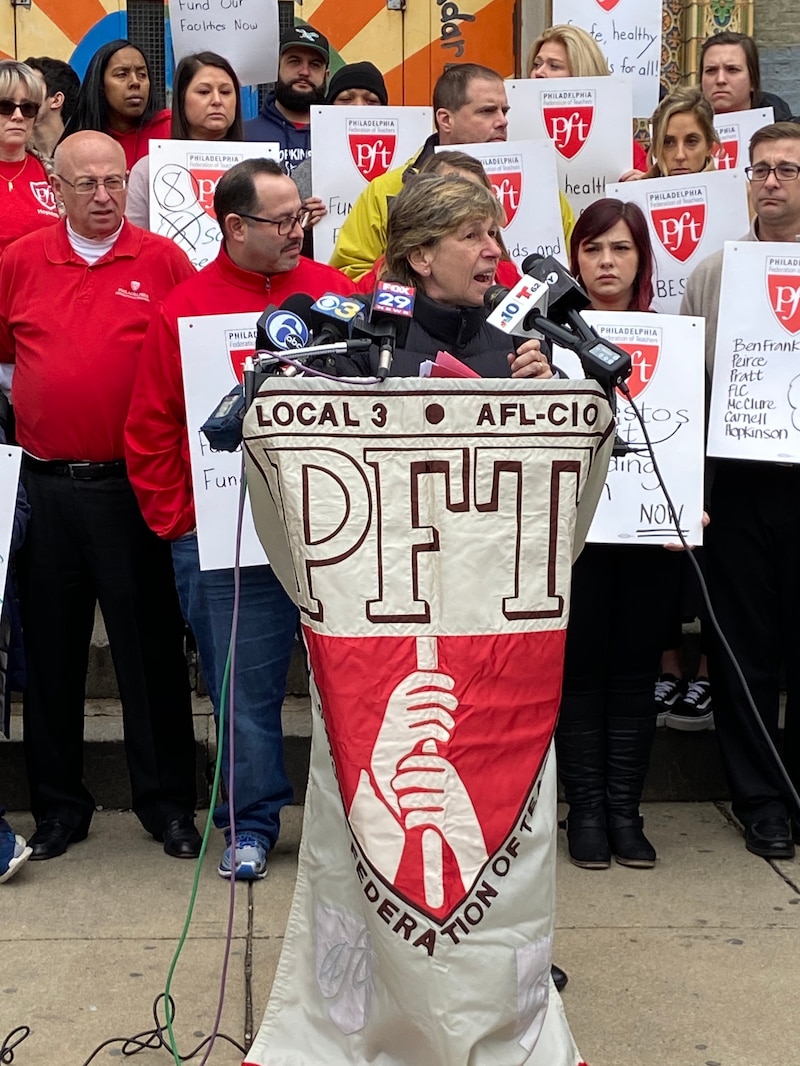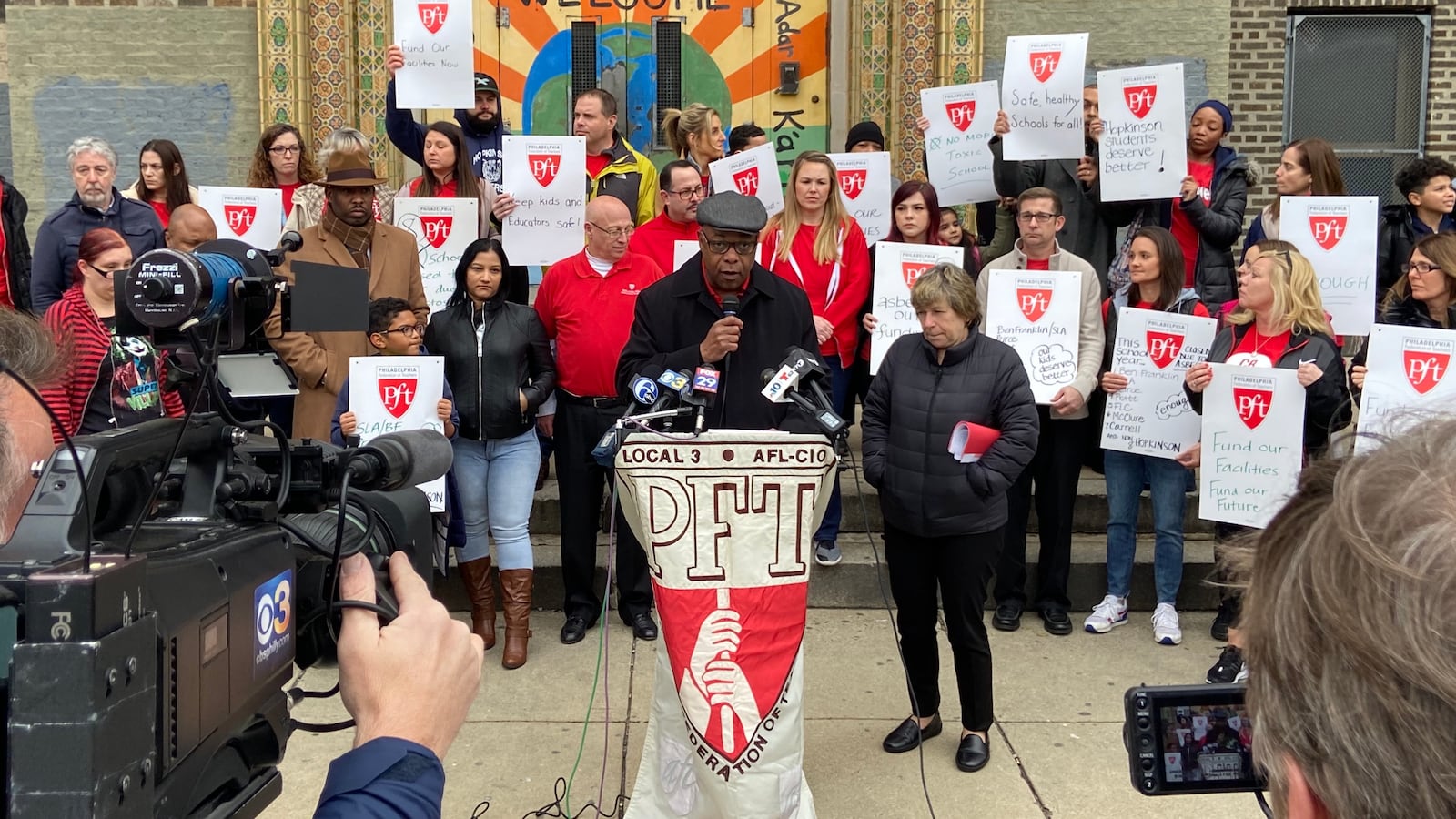This article was originally published in The Notebook. In August 2020, The Notebook became Chalkbeat Philadelphia.
Officials of the Philadelphia Federation of Teachers on Wednesday escalated their criticism of the District’s response to potentially hazardous environmental conditions in schools, calling it “wholly insufficient” and saying that the city’s unionized laborers stand ready to help tackle problems with the aging infrastructure.
At a news conference in front of the temporarily closed Hopkinson Elementary School in Juniata with PFT president Jerry Jordan and American Federation of Teachers president Randi Weingarten, Laborers Council executive director Ryan Boyer said he had 40 to 100 laborers ready to form a “rapid response team” that would swiftly respond to reports of flaking asbestos caused by damage such as broken ceiling tiles and crumbling pipes.
As Hopkinson students got off buses that had taken them to another school for the morning, Jordan held up a big red binder that he said was full of “unresolved reports related to suspected asbestos that members have submitted.”
At Hopkinson, he called the District’s actions a “horrifying breach” because the District never told the PFT or school staff that all the ceiling tiles had been replaced over the summer.
“Staff reported massive amounts of debris and dust everywhere, which they unknowingly swept up. This … exposed the entire building to an unknown but likely quite significant amount of asbestos. This situation is disastrous and also proof-positive of our inability to accept the District’s word or accept its proposed course of action.”
Plus, he said, “Their sampling effort will not allow us under any circumstances to declare the building safe.”
Superintendent William Hite swiftly responded, saying that he is happy to accept all help and was ready to have a meeting with the PFT “tomorrow” about getting more personnel working on the cleanup. Hite also disclosed that the office of Mayor Kenney has been facilitating meetings with various groups, including the PFT, to address environmental conditions in schools.
“We’ve had quite a few meetings with PFT, weekly meetings … but I would love to get as many individuals who want to help and engage in this process as possible together … as early as tomorrow so we can … agree on a process,” he said, and not argue “about what kind of test is used” to determine the safety of a building.
But Hite also defended the District’s response to hazards in schools. He and James Creedon, a consultant recently hired to be the District’s interim head of facilities and capital projects, took pains to explain how the District prioritizes the reports it receives, inspects damage, and determines which cases constitute “imminent hazards.”
Hite also suggested it was time for the District and the PFT, which has sued the District over its handling of asbestos reports, to work together.
“When adults are fighting,” he said, “children are harmed.”
So far this year, eight schools in seven buildings have been temporarily closed due to asbestos hazards.
Details were few on how much the rapid response team would cost and how it would be organized. The District has hired contractors to ramp up its abatement work; last week, the Board of Education approved $14 million in additional contracts.
Still, Hite said he supported the offer.
“I am in complete support of a rapid response team, with one caveat, and that is we have to prioritize what individuals are responding to,” he said. “We have to agree on what we will prioritize, so that we are able to also address the imminent hazards while we are also addressing all of the repairs that need to happen. I haven’t seen the rapid response plan. I understand it could be up to 100 individuals who are available to help. That would be something we would welcome.”
Hite said he had “communicated to the governor, the mayor, anyone willing to listen” that “all these issues are symptoms of a much greater problem. The greater problem is significant capital needs, where we should be talking about how do we rebuild facilities as opposed to just repairing these things that are happening in a one-off kind of way.”
Weingarten called the situation in Philadelphia a humanitarian and public health crisis and said that the state and federal governments need to help.

American Federation of Teachers president Randi Weingarten spoke at the news conference.
“This is the government’s role, nationally, state, and locally, to make sure that our children are safe,” Weingarten said. “We are here to make sure there is a safe and welcoming environment that makes sure there are no toxins in the building. What has happened here is pretty obvious and simple, and I’m saying this about the federal government today, because how dare Vice President Pence and Betsy DeVos be in this town today and not dealing with the asbestos issues and the infrastructure issues in our public schools.”
Pence and DeVos, the U.S. secretary of education, visited St. Francis DeSales Catholic School in West Philadelphia to tout a scholarship plan for private and religious schools that President Trump highlighted in his State of the Union address Tuesday night.
On Tuesday, Gov. Wolf proposed a billion-dollar package to remediate and modernize old school buildings in the state. The District has asked for $125 million from the state over five years to devote to abatement of lead in paint and pipes and abatement of asbestos, Hite said.
Asbestos problems have plagued the city schools for decades, but the concerns have intensified this school year, particularly after the diagnosis of a teacher with mesothelioma, a lung disease tied to asbestos exposure. The carcinogenic substance was widely used as insulation in buildings constructed for much of the last century, until the late 1970s. Most District buildings have asbestos, and keeping it contained and safe is a monumental, expensive task.
Asked why this issue has come to the forefront this school year, Creedon said: “The reason you’re seeing it is that we’re inspecting a lot more. We’re paying attention to it a lot more.”
But he also said that there is misinformation and misunderstanding about the danger that asbestos presents. If it is contained, it is not dangerous.
He said the District is managing “imminent hazards” now in five schools, four of which continue to operate.
As the District continues its inspections, he said, “I think there will be additional imminent hazards that are defined. The issue is, how do we as a community get a reasonable understanding of what that means” in terms of safety.
“You can manage these while schools are open. It takes a lot of cooperation, a lot of coordination, a lot of careful planning on environmental work, but we do it all the time.”
The District wants to “make all buildings asbestos-safe, not asbestos-free, but safe,” Hite said.
Hopkinson will remain closed for at least another day as the District continues to evaluate the situation, a spokesman said.


